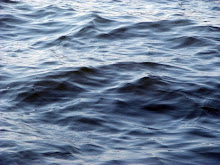
The 'fingers' are set to critical measurement points, the rabbet, where keel joins to hull, top of the garboard, or first plank up, and at every lap until reaching the sheer, or top of the hull.

The measurements are recorded and the lines for each section are drawn on a piece of ply . It gets a little congested where the lines converge.

A batten, a thin strip of wood, is used to plot the measurements and allow drawing a line of the hull shape at a particular station.

This is how it's done. The jig is laid down on the table to a preset position. The position of the ends of the fingers indicate the various measure points (at the laps). These are marked on the board,

measured, and the measurement recorded into a sort of spreadsheet, called a table of offsets. A table of offsets (shown above) represents a set of numerical measurements in three dimensions which will allow a designer or draftsman to recreate a drawn picture of the boat.

And now taking the measurement from the drawn line to a baseline, giving the height of a point on the hull.

Here Steve is pinning the batten to draw a lie for the next to last station, no.9. Stations are cross sections through the hull at measured intervals, and the measurements describe the hull shape numerically.

I rarely like posed photos, but really felt this was an 'historic' moment, with the line being taken off Sjogin to be preserved for posterity. Russ and Steve reluctantly obliged
all images thomas armstrong
A little poetic license taken in the title for this post, actually, Sjogin described, or documented would be more accurate. Sjogin turns heads, both in person and on the internet, and it's easy to see why. Probably built by a retired Swedish ship captain, there's no denying that, whether by luck or by true artistry and insight, the design of this boat distills the essence of Scandinavian working craft and has an ineluctable charm. I am far from being the only admirer who shares this opinion. Back in February, a WoodenBoat Forum thread was started by 'RodB' about how to get the lines taken off so Sjogin could be reproduced. A gentle firestorm ensued, and to date there have been 271 posts on the thread. Several designers were approached, and at least three, Francois Vivier, Paul Gartside and John Welsford have expressed real interest in producing a set of plans for boats built in their attendant styles based on Sjogin's lines, with the intention of adhering very closely to the original lines of the boat, though with possible variations in the material and construction used. These would be plans available and accessible drawn with the home builder in mind. Two of the designers, Paul Gartside and Francois Vivier have already formed pools of subscribers, meaning interested parties who'd like to get a set of plans, and who band together to raise the funds to pay the initial design fee. Inquire if you are interested. Both Francois and Paul have done preliminary sketches based on photos of Sjogin, but in order to actually draw up plans from which a boat can be built, they need accurate measurements from several areas of the boat. This part's not about imagination, but precision, as the intent is to replicate that indescribable sweetness of this boat, this design.
Paul Gartside sent Russ Mannheimer, Sjogin's owner, detailed instructions on hoe to 'take off lines', ie, to take the measurements a designer would need to draw the boat in three dimensions. There are several ways of doing this and the method Paul described is simple and low tech, but the work is exacting.
The bulk of the work was done last Wednesday, by Russ and his accomplice, Steve Martinsen, up from Oxford, MD. The measuring took place at the venerable boatyard David Beaton and Sons, in Brick, New Jersey. Beaton's is a third generation boatyard still building and caring for wooden boats, and has a fabled history, more on the boatyard later. Beaton's is Sjogin's home, and exudes an atmosphere of the past, moving into the future, a real treasure.
I arrived at Beaton's in the afternoon to find Russ and Steve hard at work. They divided the work, Russ using a jig with fingers set to each of the salient measure points, then laying the jig on a board so Steve could measure the points of each of ten cross sections through the hull, and then measure, record and draw the curve. It was interesting to see this process, but I didn't get it all and am probably not explaining it very well. If you'd like to dig into how this process is done, there's an excellent ebook/resource put out by the Museum Small Craft Association. This is the go to text for documenting boats. I'll also recommend investigating this association, a group worthy of your attention.
All in all, a good day, even great, seeing Sjogin documented for all time. That doesn't imply that clones built to her lines will possess the same grace as Sjogin, but all will replicate her seaworthiness, if built correctly and if lucky have a little of her magic as well.





































3 comments:
I know the concept of taking lines has been in your thoughts for a while. So glad you got to realize a dream. Great Photos, too.
Don't you just love that place? My entire being just relaxes when I drive down that lane. I tried really hard to show up that day, but now I feel like I was there! Thanks, Thomas!
Yes, I do love the place, it's a real treasure, should be on the national register. A bit of heritage and very much alive today. I commented to one salt the day I was there that it was a candy store for boat lovers.
Post a Comment